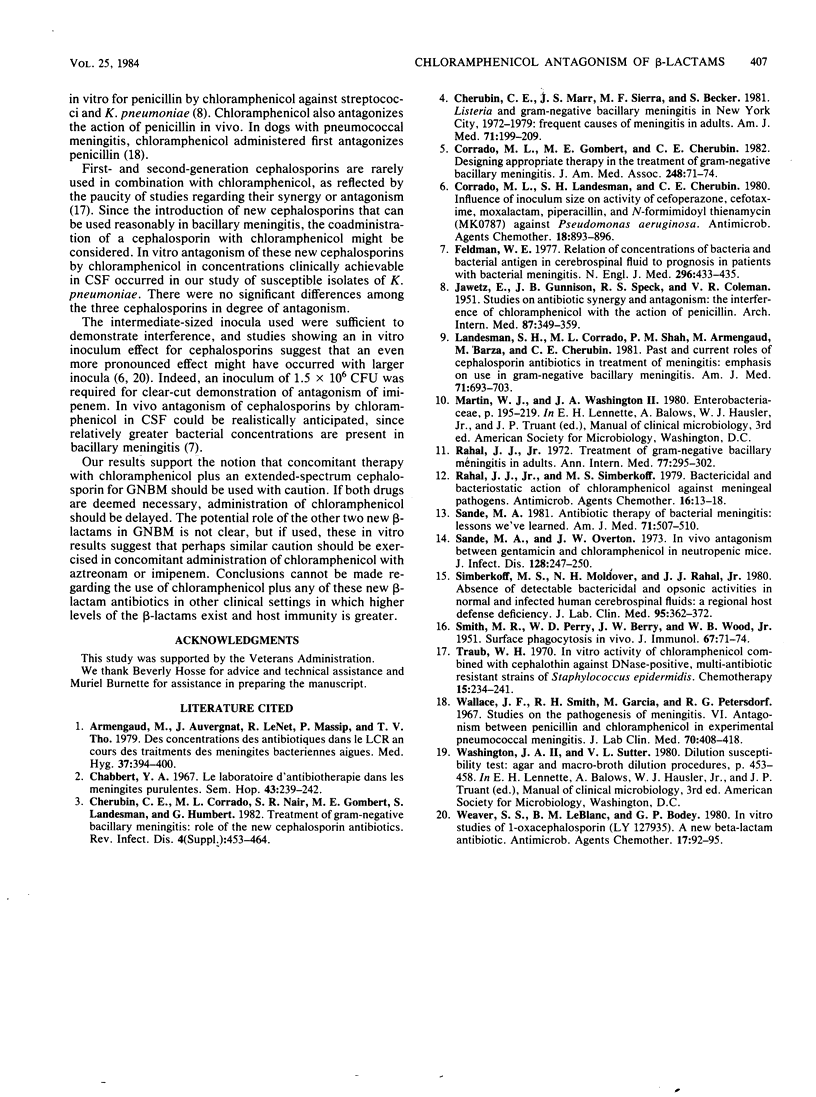Abstract
Chloramphenicol combined with cefotaxime, moxalactam, cefoperazone, aztreonam, or imipenem was tested in vitro against clinical isolates of Klebsiella pneumoniae. By time-kill cultures (killing curves), chloramphenicol interfered with activity of all five beta-lactams. When chloramphenicol was added before the beta-lactams, the action of cefotaxime, moxalactam, or cefoperazone against all isolates was antagonized at all times tested. The action of aztreonam was antagonized against four of six isolates. With imipenem, antagonism occurred against half of the isolates at some time during 24 h when chloramphenicol was added simultaneously, provided that a sufficient inoculum of K. pneumoniae was employed. Generally, less antagonism resulted when chloramphenicol was added after the cephalosporins. Interference of bactericidal activity of three new cephalosporins by chloramphenicol has potential clinical relevance to the therapy of gram-negative bacillary meningitis. The lesser antagonism of aztreonam and imipenem by chloramphenicol is of uncertain clinical relevance but indicates that this in vitro phenomenon may apply to a wide range of beta-lactam antibiotics.
Full text
PDF


Selected References
These references are in PubMed. This may not be the complete list of references from this article.
- Chabbert Y. A. Le laboratoire d'antibiothérapie dans les méningites purulentes. Sem Hop. 1967 Jan 20;43(4):239–242. [PubMed] [Google Scholar]
- Cherubin C. E., Marr J. S., Sierra M. F., Becker S. Listeria and gram-negative bacillary meningitis in New York City, 1972-1979. Frequent causes of meningitis in adults. Am J Med. 1981 Aug;71(2):199–209. doi: 10.1016/0002-9343(81)90106-6. [DOI] [PubMed] [Google Scholar]
- Corrado M. L., Gombert M. E., Cherubin C. E. Designing appropriate therapy in the treatment of gram-negative bacillary meningitis. JAMA. 1982 Jul 2;248(1):71–74. [PubMed] [Google Scholar]
- Corrado M. L., Landesman S. H., Cherubin C. E. Influence of inoculum size on activity of cefoperazone, cefotaxime, moxalactam, piperacillin, and N-formimidoyl thienamycin (MK0787) against Pseudomonas aeruginosa. Antimicrob Agents Chemother. 1980 Dec;18(6):893–896. doi: 10.1128/aac.18.6.893. [DOI] [PMC free article] [PubMed] [Google Scholar]
- Feldman W. E. Relation of concentrations of bacteria and bacterial antigen in cerebrospinal fluid to prognosis in patients with bacterial meningitis. N Engl J Med. 1977 Feb 24;296(8):433–435. doi: 10.1056/NEJM197702242960806. [DOI] [PubMed] [Google Scholar]
- JAWETZ E., GUNNISON J. B., SPECK R. S., COLEMAN V. R. Studies on antibiotic synergism and antagonism; the interference of chloramphenicol with the action of penicillin. AMA Arch Intern Med. 1951 Mar;87(3):349–359. doi: 10.1001/archinte.1951.03810030022002. [DOI] [PubMed] [Google Scholar]
- Landesman S. H., Corrado M. L., Shah P. M., Armengaud M., Barza M., Cherubin C. E. Past and current roles for cephalosporin antibiotics in treatment of meningitis. Emphasis on use in gram-negative bacillary meningitis. Am J Med. 1981 Oct;71(4):693–703. doi: 10.1016/0002-9343(81)90240-0. [DOI] [PubMed] [Google Scholar]
- Rahal J. J., Jr, Simberkoff M. S. Bactericidal and bacteriostatic action of chloramphenicol against memingeal pathogens. Antimicrob Agents Chemother. 1979 Jul;16(1):13–18. doi: 10.1128/aac.16.1.13. [DOI] [PMC free article] [PubMed] [Google Scholar]
- Rahal J. J., Jr Treatment of gram-negative bacillary meningitis in adults. Ann Intern Med. 1972 Aug;77(2):295–302. doi: 10.7326/0003-4819-77-2-295. [DOI] [PubMed] [Google Scholar]
- SMITH M. R., PERRY W. D., BERRY J. W., WOOD W. B., Jr Surface phagocytosis in vivo. J Immunol. 1951 Jul;67(1):71–74. [PubMed] [Google Scholar]
- Sande M. A. Antibiotic therapy of bacterial meningitis: lessons we've learned. Am J Med. 1981 Oct;71(4):507–510. doi: 10.1016/0002-9343(81)90191-1. [DOI] [PubMed] [Google Scholar]
- Sande M. A., Overton J. W. In vivo antagonism between gentamicin and chloramphenicol in neutropenic mice. J Infect Dis. 1973 Aug;128(2):247–250. doi: 10.1093/infdis/128.2.247. [DOI] [PubMed] [Google Scholar]
- Simberkoff M. S., Moldover N. H., Rahal J., Jr Absence of detectable bactericidal and opsonic activities in normal and infected human cerebrospinal fluids. A regional host defense deficiency. J Lab Clin Med. 1980 Mar;95(3):362–372. [PubMed] [Google Scholar]
- Traub W. H. In vitro activity of chloramphenicol combined with cephalothin against D-Nase-positive, multiple-antibiotic resistant strains of Staphylococcus epidermidis. Chemotherapy. 1970;15(4):234–241. doi: 10.1159/000220687. [DOI] [PubMed] [Google Scholar]
- Wallace J. F., Smith R. H., Garcia M., Petersdorf R. G. Studies on the pathogenesis of meningitis. VI. Antagonism between penicillin and chloramphenicol in experimental pneumococcal meningitis. J Lab Clin Med. 1967 Sep;70(3):408–418. [PubMed] [Google Scholar]
- Weaver S. S., LeBlanc B. M., Bodey G. P. In vitro studies of 1-oxacephalosporin (LY 127935), a new beta-lactam antibiotic. Antimicrob Agents Chemother. 1980 Jan;17(1):92–95. doi: 10.1128/aac.17.1.92. [DOI] [PMC free article] [PubMed] [Google Scholar]


